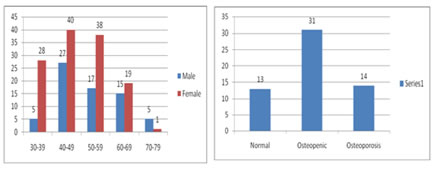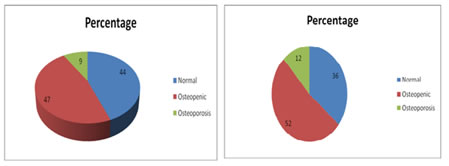Official Journals By StatPerson Publication
|
Table of Content - Volume 9 Issue 1 - January 2019
Cross sectional study to determine the prevalence of osteoporosis and osteopenia in rural people of Thiruvarur district, Tamil Nadu, India
P Udhayasingh1, S Thiruchelvi2*
1,2associate Professor Of PMR, Government Thiruvarur Medical College Hospital, Thiruvarur, Tamil Nadu, INDIA. Email: udhayasingh2014@gmail.com
Abstract Osteoporosis is the major health problem affecting all age groups in both developed and developing countries. Most of the studies were done to identify Osteoporosis prevalence in urban people of India. This cross sectional study was carried out to analyse the prevalence of Osteoporosis and Osteopenia in rural people of Thiruvarur district, Tamil Nadu. We will prevent disability due to fractures and other Osteoporosis related complications by proper health advices and awareness program after deteccting Osteoporosis and Osteopenia by Quantitative Ultrasound Method. After Institutional Ethical Committee Approval, This study was carried out by department of PMR (Physical Medicine and Rehabilitation), Government Thiruvarur Medical College, Thiruvarur, Tamil Nadu, India. 195 people with rural background between 30 years to 70 years attended the free BMD (Bone Mineral Density) Camp conducted by Department of PMR. That people were subjected to do bone mineral density measurement by Calcaneal Quantitative Ultrasound after getting informed consent. Key Word: Osteoporosis, Osteopenia, Quantitative Ultrasound
INTRODUCTION Osteoporosis is one of the major health problems with the progressive prevalence in developing countries. According to WHO criteria, Osteoporosis is reduction in Bone Mineral density of 2.5 standard deviation or more below that of the Mean Peak BMD of young adults when measured by Dexa Scan. The condition is influenced by different risk factors in terms of sex and age. By 2050 worldwide insurance of Hip fracture is expected to rise by 240 % in women and 310% in men. The cost of Osteoporosis treatment is greater than pre fracture cost. It is easy to measure BMD but in clinical setting bone quality is not measurable yet. Bone Mineral Density is measured by MEANS OF DUAL X-RAY Absorptiometry (DEXA). It is the actual expression of bone in absolute terms of mineral per square centimeters of the scanned bone. BMD measurements of Hip and Spine are used to establish or confirm the diagnosis of Osteoporosis to predict the future fracture risk and monitor the patient. The Difference between the patient’s BMD and mean BMD young females aged in the large of 20 – 29 years (divided by the standard division (SD) of the reference population) yield to T-Score. Comparing the BMD of particular age, sex and ethnicity matched adult reference population is called Z-Score. There are several limitations of DEXA which prevent it from being used in screening of Osteoporosis. C CalcanealQuantitative Ultrasound (QUS) is a bone health assessment technique which has gained popularity in recent year. Compared to DEXA, QUS offers wide accessibility to the public because it is portable, easier to handle, lower in cost and does not emit ionizing radiation.
AIM The main purpose of this clinical study is to determine the prevalence of Osteopenia and Osteoporosis in rural people attended Free BMD camp, conducted in OPD–Department of PMR at Government Thiruvarur Medical College Hospital, Thiruvarur and compare the BMD (Bone Mineral Density) in relation to modifiable and non modifiable risk factors by doing a Quantitative Ultrasound method.
OBJECTIVES To analyse the reason for the prevalence for Osteoporosis and Osteopenia in rural people of Thiruvarur District, Tamil Nadu and to plan for an Osteoporosis awareness programme, thereby to prevent disability due to fracture and other Osteoporosis related complications. This study is useful for upgrading the medical science in Osteoporosis management.
METHODS AND MATERIALS After the institutional ethical committee clearance, this Cross Sectional Study was done at the Department of PMR, Government Thiruvarur Medical College Hospital, Thiruvarur, Tamil Nadu. Patients attended the free BMD camp were subjected to do.
Inclusion Criteria:
Exclusion Criteria:
DEXA is the gold standard for bone mineral density evaluation. But Calcaneal QUS is reliable and cost effective alternative which was used in the study. QUS was used to calculate BMD of right heal. Machine converted the BMD value into ‘T’ Score. All good clinical practice (GCP) guidelines were followed. Details regarding work up of patients including demographic and clinical details and history of smoking, diabetes status and nutritional history menopausal status were recorded. The results were tabulated and analysed statistically. Test of significance (chi square test and Z test) to be applied wherever necessary. Figure 1: Age Wise Classification Figure 2: Menopausal
Figure 3: Hypertension RESULTS Out of 195, Osteopenic were 107 and 27 were Osteoporosis. More than 68 present were affected due to Osteoporosis and Osteopenia. In Menopausal women, 31 percent are Osteopenic and 14 percent are Osteoporosis. In Hypertensive patients, 47 percent are Osteopenic and 9 percent are Osteoporosis. In Diabetic patients 52 percent are Osteopenic and 12 percent are Osteoporotic. In Smokers, 69% were osteopenic and 26% were osteoporotic.
DISCUSSION Worldwide Osteoporosis causes more than 8.9 million fractures annually. Osteoporosis is estimated to affect 200 million women worldwide. Disability due to Osteoporosis complications is greater than disability caused by any other diseases. Osteoporosis complications are major health problem in India also. Osteoporosis affects both urban and rural population. Disability due to osteoporosis is preventable. It is easy to measure bone mineral density by Quantitative Ultrasound. We found that from our study Osteoporosis and Osteopenic are more prevalent in rural people also. Patients with systemic diseases are Osteopenic and Osteoporosis. This is the time to treat these high-risk cases. Thereby we will prevent major disability due to Osteoporosis and to prevent economic burden to these families.
CONCLUSION We found that Osteoporosis and Osteopenia are more prevalent in rural population of Thiruvarur district, Tamil Nadu. Prevalence is present in Post Menopausal Women, Old age and Patients with systemic Diseases. Calcium and D3 prescription were given to the affected people with the advice of Physical Exercises, Dietary habits and importance of SUN EXPOSURE.
REFERENCES
|
|
 Home
Home

 Figure 4: Diabetic
Figure 4: Diabetic